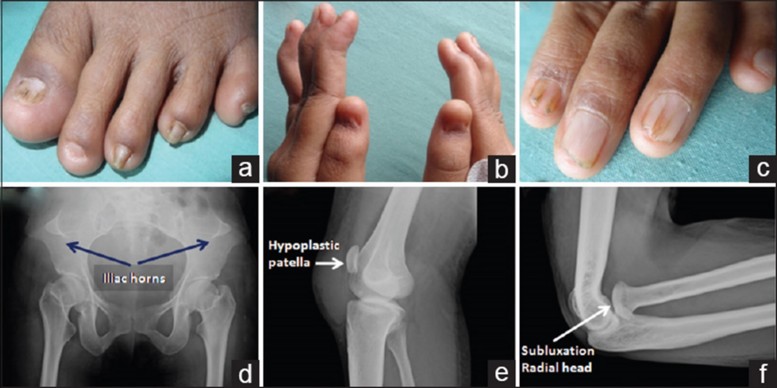(Hood syndrome, Turner-Kieser syndrome, Fong disease, hereditary osteo-onychodysplasia)
Very rare. Autosomal dominant transmission with high penetrance and variable expressivity. Mutation of the LMX1B gene (9q34.1) a transcription factor which interferes with the expression of collagen IV and podocine. At electron microscopy: presence of collagen fibrils in the thickened basal membrane of apparently normal glomeruli.
Association of:
- dysplasia of the nails of the fingers and toes: hypoplasia, discolored, cracked (especially at the level of thumbs)

- aplasia or hypoplasia of the patella: subluxation of knee, pain
- webbing of skin at the elbows, subluxation of the head of the radius: incomplete extension
- kidney disease (proteinuria) that appears in childhood or later in 30-40 % of cases and progresses to chronic renal failure in 10 % of cases
- exostoses of the anterior iliac crests: 'iliac horns'
- occasionally: open angle glaucoma, dark pigmentation of the clover-shaped iris, cleft lip or palate, mental retardation, spina bifida occulta, dural ectasias, scoliosis, hypoplasia of some muscles (pectoral, quadriceps)
- sometimes: polyneuropathy with vasomotor dysfunction (adult): anomalies of the dopaminergic and serotonergic tracts at the brainstem level ?
Anesthetic implications:
check blood electrolytes, creatinine,; ECG and question about rhthym disorders/syncopes in the medical history; anticipate difficulties for venous access ; risk of thrombosis (central venous access); check for glaucoma. Risk of difficult intubation in case of cleft lip palate. Neuraxial blocks: risk of scoliosis, spina bifida occulta, dural ectasias. Pharmacology: impact of renal insufficiency or failure if present, avoid NSAID's.
References :
- Hennessey TA, Backman SB, Meterissian SH, Schriker T.
Nail-patella syndrome: a case report and anesthetic implications.
Can J Anaesth 2007; 54: 835-9. - Wood D, Silva S, Selvan D.
Nail-patella syndrome in pregnancy.
Anaesthesia Cases 2013 ; 1 : 11-3.
Updated: February 2021
.